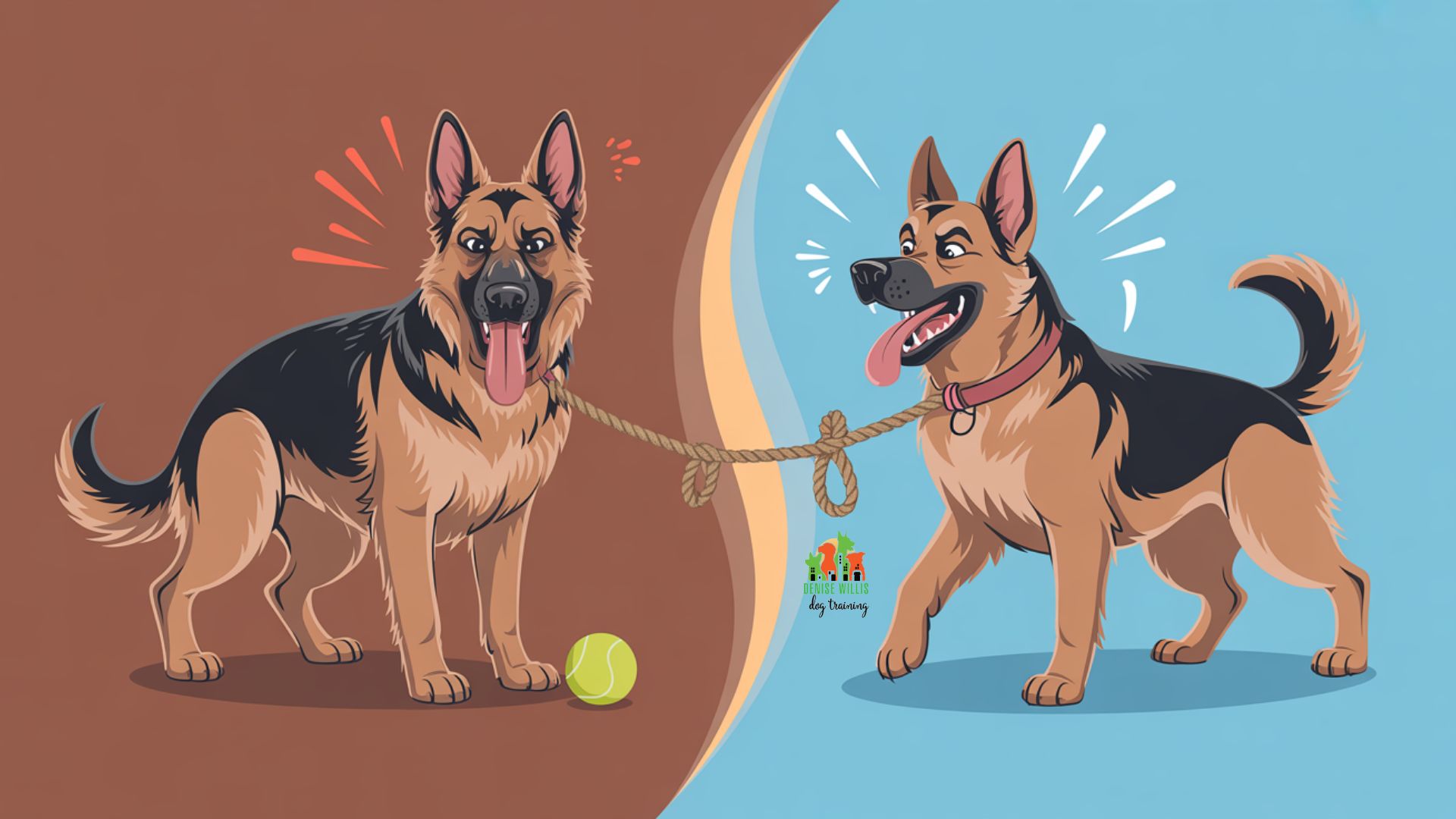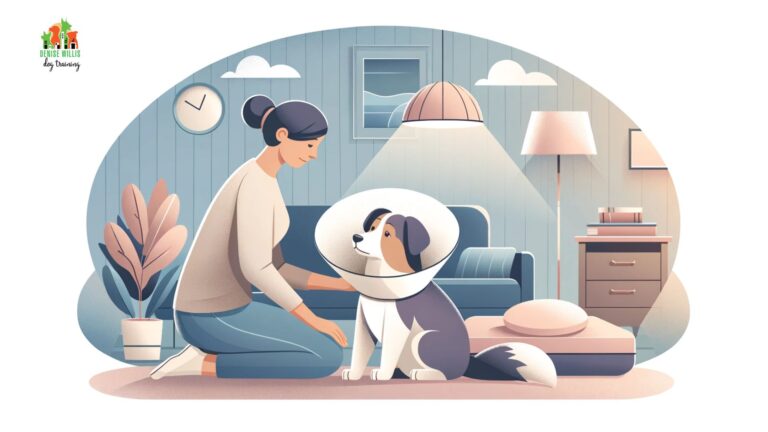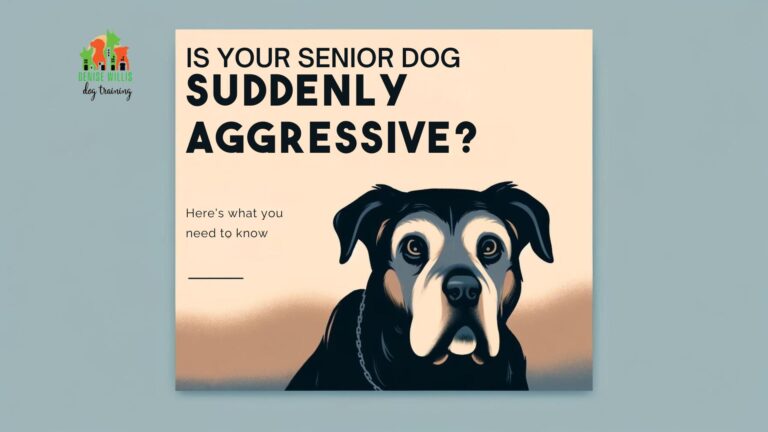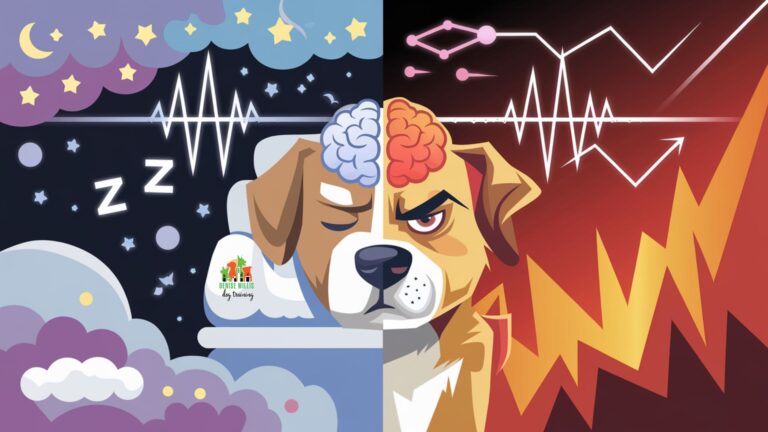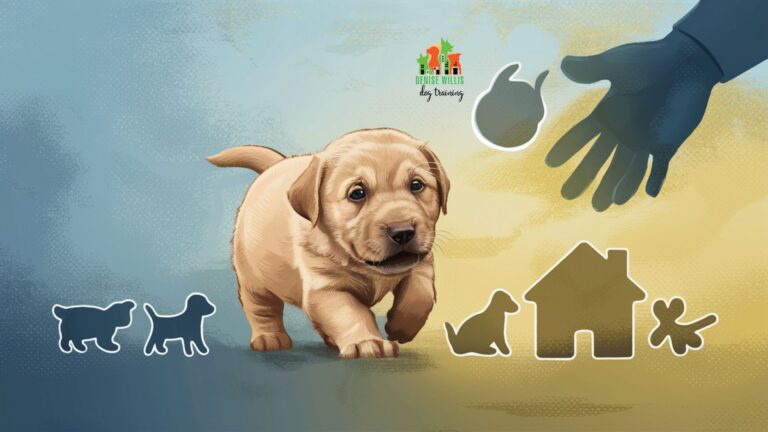Playful Solutions: Using Games to Reduce Dog Aggression
📍 Service Area Notice: DW Dog Training provides in-person training services exclusively in the Greater Baltimore area. While our blog content is designed to help dog owners internationally, our hands-on training services are locally focused. For readers outside our service area, we hope you find value in our articles and welcome you to reach out with questions!
Ever wonder why your dog transforms from Dr. Jekyll to Mr. Hyde the moment another dog appears on the horizon?
The secret to calming that inner beast might not be found in dominance training or harsh corrections, but rather in something as simple as a game of fetch or a puzzle toy. Research shows that structured play can reduce aggressive behaviors by up to 50% when consistently applied, making it one of the most powerful tools in modern dog training. The science behind this transformation lies in the neurochemical changes that occur during play, including the release of serotonin, dopamine, endorphins, and oxytocin, all of which promote relaxation, trust, and stress relief. Daily play therapy sessions can lower cortisol levels by 28%, leading to calmer, less reactive dogs who are better equipped to handle challenging situations. Unlike punishment-based methods that often escalate aggression, play-based solutions address the root causes of reactive behavior while strengthening the bond between you and your furry companion.
Your dog’s journey from aggressive to awesome might be just one well-timed game away.
Key Takeaways
- Mental Stimulation Benefits: Brain games release calming neurochemicals, including serotonin and dopamine, while reducing stress hormones that fuel aggressive responses
- Impulse Control Development: Structured games teach self-regulation skills and help dogs learn to redirect focus away from triggers toward positive activities
- Confidence Building: Success in play activities reduces anxiety-based reactive behaviors by building a dog’s sense of accomplishment and security
- Positive Association Creation: Counter-conditioning through play changes emotional responses to triggers, replacing fear and frustration with excitement and anticipation
- Bond Strengthening: Interactive games build trust, communication, and mutual enjoyment between dog and handler, creating a foundation for better behavior
- Energy Outlet Provision: Physical and mental stimulation prevents the buildup of frustration and pent-up energy that often leads to aggressive outbursts
- Real-world Application: Evidence-based strategies can be implemented safely at home with proper guidance and gradual progression techniques
How Play Reduces Dog Aggression
50% Reduction
Daily 60-minute exercise routines reduce aggressive behaviors by 50% in just 12 weeks, providing measurable behavioral improvement.
3x Less Likely
Dogs receiving 7+ hours of exercise weekly are three times less likely to develop aggressive behaviors over time.
89% Expert Agreement
Professional dog trainers overwhelmingly rate regular exercise and play as “very important” for managing dog aggression.
70% Reduction
Well-socialized dogs through structured play are 70% less likely to develop fear-based aggression compared to under-socialized dogs.
The Science Behind Play-Based Aggression Reduction
Understanding why play works to reduce aggression requires diving into the fascinating world of canine neurochemistry and behavioral psychology. When dogs engage in structured play activities, their brains undergo significant chemical changes that promote emotional regulation and stress relief. This isn’t just feel-good theory, it’s backed by solid research showing measurable improvements in both physiological markers and behavioral outcomes. The transformation happens at a cellular level, making play one of the most effective tools for addressing aggressive tendencies in dogs of all ages and backgrounds.
How Play Rewires the Aggressive Brain
The magic of play therapy lies in its ability to trigger a cascade of beneficial neurochemicals that directly counteract the stress hormones responsible for aggressive behavior. Our research on hormonal influences on dog aggression shows that during engaging play sessions, dogs experience increased production of serotonin, dopamine, endorphins, and oxytocin, creating what researchers call a “chemical cocktail of calm.” Studies from our research on mental stimulation and dog aggression have shown that daily play therapy sessions can lower cortisol levels by 28%, leading to calmer, less reactive dogs who are better equipped to handle stressful situations. Mental stimulation through games can reduce aggressive behaviors by up to 50% when consistently applied, according to findings on how exercise reduces aggression, making it more effective than many traditional training methods.
This neurochemical shift creates lasting changes in how dogs perceive and respond to potential triggers. Through a process called counter-conditioning, play helps dogs develop new, positive associations with situations that previously caused fear or frustration. Research on using play to treat aggression demonstrates how a dog who becomes aggressive when strangers approach can learn to associate the sight of new people with the excitement of their favorite tug game, completely changing their emotional response from defensive to anticipatory.
The Stress-Aggression Connection
Aggression rarely occurs in a vacuum, it’s typically the result of accumulated stress, frustration, or fear that has nowhere else to go. Dogs with insufficient mental and physical stimulation often develop what behaviorists call “displacement behaviors,” which can manifest as excessive barking, destructive chewing, or aggressive reactions to normal stimuli. Research on play training for aggressive dogs shows that play provides a crucial outlet for this pent-up energy while simultaneously teaching dogs more appropriate ways to express themselves.
The stress-reduction benefits of play extend far beyond the immediate session. Regular engagement in mentally stimulating activities helps dogs develop better coping mechanisms and emotional resilience. When faced with challenging situations, dogs who have learned to self-regulate through play are more likely to seek out appropriate outlets rather than defaulting to aggressive responses. This creates a positive feedback loop where good behavior is reinforced through enjoyable activities, making future success more likely, as documented in studies on dog laughter and stress reduction.
Game-Based Strategies for Different Aggression Types
Not all aggression is created equal, and neither should be the games used to address it. Different types of aggressive behavior require targeted approaches that address the underlying emotional states and triggers. Fear-based aggression needs confidence-building activities, while redirected aggression benefits from impulse control games. Understanding these nuances allows dog owners to select the most effective play strategies for their specific situation. The key is matching the right type of mental stimulation to the dog’s individual needs and comfort level, according to our comprehensive guide on dog aggression solutions.
Fear-Based Aggression Solutions
Dogs who display aggressive behavior due to fear or anxiety benefit most from low-pressure, confidence-building activities that allow them to succeed at their own pace. Scent work and puzzle toys represent excellent starting points because they engage a dog’s natural instincts without requiring direct interaction with potential triggers. Research on play development and behavior shows that these activities build confidence through problem-solving success while providing mental stimulation that reduces overall stress levels.
Solo activities like snuffle mats, treat-dispensing toys, and hide-and-seek games with favorite objects allow fearful dogs to experience positive emotions in a controlled environment. As documented by research on the importance of play, these games help dogs learn that good things happen in their environment, gradually shifting their default emotional state from suspicious to optimistic. The key is starting with very easy challenges and gradually increasing difficulty as the dog’s confidence grows.
Food puzzles serve a dual purpose for anxious dogs by providing mental stimulation while creating positive associations with problem-solving. Our research on dog aggression vs playfulness demonstrates how structured mental challenges help dogs develop emotional regulation skills that transfer to real-world situations. These activities teach dogs that persistence and calm behavior lead to rewards, countering the impulsive reactions that characterize fear-based aggression.
Reactive and Leash Aggression Games
For dogs who become aggressive or overly excited when encountering triggers like other dogs, people, or specific environments, focus-redirection games prove invaluable. The “Engage-Disengage” game, as outlined in clicker training research on reducing leash reactivity, teaches dogs to look at a trigger and then immediately turn back to their handler for a reward. This simple exercise helps dogs learn that the appearance of a trigger predicts good things from their human, rather than signaling a need to react defensively.
Research on reactive dog training games demonstrates how the “Look at That” technique can transform a dog’s response to triggers. Instead of trying to avoid or control the trigger, dogs learn to notice it calmly and then refocus on their handler. High-value games like tug-of-war or fetch can serve as powerful rewards for this calm behavior, as they’re often more motivating than food treats for highly aroused dogs.
The beauty of these techniques lies in their ability to change the dog’s emotional state at the neurochemical level. When a reactive dog successfully performs the engage-disengage sequence, their brain releases the same calming neurochemicals associated with play, creating new neural pathways that compete with aggressive responses. Over time, the sight of a trigger becomes a cue for excitement and anticipation rather than fear or frustration.
Resource Guarding and Possessive Behavior
Dogs who display aggression around food, toys, or other valuable resources benefit from games that teach patience and impulse control while building positive associations with a human approach. Trading games, where dogs learn to willingly give up one item in exchange for something even better, help reduce the anxiety that often drives possessive behavior. According to guidance on tug-of-war without encouraging aggression, structured games with clear rules help dogs understand that humans are sources of good things, not threats to their resources.
Food puzzles and slow-feeding toys serve dual purposes for resource-guarding dogs. They provide mental stimulation while teaching dogs that good things come from working with, rather than against, their environment. These tools help reduce the frantic, competitive eating that can escalate into guarding behavior while building problem-solving confidence. Our research on stress-induced dog aggression shows how reducing mealtime anxiety through puzzle feeders can significantly decrease overall stress levels and reactive behaviors.
The “Wait” game becomes particularly powerful for resource-guarding dogs, teaching them that patience and self-control lead to access to valuable items. This game involves asking the dog to wait before approaching their food bowl, toy, or other resource, then releasing them with a verbal cue. Over time, dogs learn that human presence and commands actually facilitate access to resources rather than threatening them, fundamentally changing their emotional response to potential competition.
Practical Implementation Guide
Successfully implementing play-based aggression reduction requires more than just buying a few toys and hoping for the best. The process demands careful planning, consistent execution, and a deep understanding of your dog’s individual triggers and comfort zones. Safety considerations must always come first, especially when working with dogs who have a history of aggressive behavior. The goal is to create positive experiences that build confidence and trust while avoiding situations that might escalate tension or reinforce negative associations. According to our comprehensive approach to mental stimulation and aggression, the most successful programs start slowly and build momentum over time.
Getting Started with Aggressive Dogs
The first step in any play-based intervention involves a thorough assessment of your dog’s current behavioral patterns and trigger identification. Safety protocols should include using appropriate equipment, maintaining adequate space, and having an exit strategy for every training session. Research on play training for aggressive dogs emphasizes starting with solo activities that don’t require direct interaction with triggers, allowing dogs to experience success in a controlled environment.
Begin with simple puzzle toys or treat-dispensing games that engage your dog’s natural problem-solving instincts without creating pressure or competition. These activities provide mental stimulation while allowing dogs to work at their own pace, building confidence through successful problem-solving experiences. For dogs with severe anxiety or fear-based aggression, creating a calm environment becomes essential for effective learning.
Reading your dog’s body language during these initial sessions provides crucial information about their comfort level and progress. Signs of stress include panting, pacing, excessive drooling, or inability to focus on the task. Positive indicators include relaxed body posture, engaged tail movement, and sustained interest in the activity. Document these observations in a behavior journal to track patterns and progress over time, as recommended in our research on consistency in addressing dog aggression.
Daily Routine Integration
Consistency remains the cornerstone of successful play-based aggression reduction. Research on how exercise reduces aggression shows that dogs benefit most from multiple short sessions throughout the day rather than one long training period. Morning sessions can help set a positive tone for the day, while evening activities provide an outlet for accumulated stress and energy.
The timing of play sessions can significantly impact their effectiveness. Scheduling games before potentially stressful events, such as walks or visitors arriving, helps dogs enter challenging situations in a more positive emotional state. Having training tools readily available allows for spontaneous training opportunities when your dog displays calm behavior around triggers.
Environmental management plays a crucial role in success. Creating designated play spaces where dogs feel safe and comfortable helps establish positive associations with training activities. Comfortable resting areas serve as a “home base” where dogs can retreat when feeling overwhelmed, while self-soothing tools provide opportunities for stress relief during challenging periods. Our research on environmental triggers for dog aggression demonstrates how thoughtful environmental design can support behavioral progress.
Advanced Techniques for Persistent Cases
Dogs with deeply ingrained aggressive patterns may require more sophisticated approaches that combine multiple training modalities. The integration of professional guidance becomes particularly important when dealing with severe cases or when initial progress plateaus. Our experience with complex aggression cases shows that combining play therapy with traditional obedience training often yields the best results.
Counter-conditioning protocols involve systematically changing a dog’s emotional response to specific triggers through carefully orchestrated positive experiences. This might involve gradually decreasing the distance to a trigger while engaging in high-value games, or teaching dogs to perform specific behaviors that are incompatible with aggression. Mental challenges help dogs develop problem-solving confidence that translates to better decision-making in stressful situations.
For dogs with underlying health issues that might contribute to defensive behavior, addressing physical discomfort becomes essential for training success. Our research on pain-induced aggression shows how undiagnosed pain can sabotage even the best training programs. Joint support, comfortable resting areas, and mobility aids can reduce physical stress and create more positive associations with movement and positioning.
Success Stories and Real-World Applications
The theoretical benefits of play-based aggression reduction come to life through real-world success stories that demonstrate the transformative power of structured games and positive reinforcement. These cases illustrate how different approaches work for various types of dogs and aggression patterns. From shelter dogs with unknown histories to family pets who developed reactive behaviors later in life, play therapy has proven effective across diverse populations and circumstances. The key lies in matching the right techniques to each dog’s individual needs and maintaining consistency throughout the training process, as documented in numerous case studies from behavioral research institutions.
Case Study Examples
One of the most compelling examples comes from research on play training for aggressive dogs, which documented a German Shepherd and Husky mix with severe leash reactivity who learned to redirect her focus from passing dogs to her favorite tug game. Through systematic counter-conditioning, this dog transformed her response from lunging and barking to seeking out her handler for an exciting game whenever she spotted another dog. The process took approximately six weeks of consistent training, with noticeable improvements appearing within the first two weeks.
Shelter environments provide particularly challenging testing grounds for play-based interventions, yet research on dog laughter and stress reduction shows remarkable success rates. Dogs exposed to recorded dog laughter and structured play programs demonstrated significant reductions in stress-related behaviors and aggressive responses. These improvements weren’t just temporary; follow-up studies showed that dogs maintained their improved behavior patterns even after adoption into new homes.
Working breed dogs often present unique challenges due to their high energy levels and intense focus, but they also tend to respond exceptionally well to mentally stimulating games. Research on using play to treat aggression documents cases where Border Collies and German Shepherds with aggressive tendencies toward livestock or other animals learned to channel their herding instincts into appropriate games and activities. The key was providing outlets that satisfied their genetic predispositions while teaching impulse control and handler focus.
Measuring Progress
Successful implementation of play-based aggression reduction requires systematic tracking of behavioral changes and emotional improvements. Behavior journals provide invaluable insights into patterns, triggers, and progress over time. Key metrics include frequency of aggressive incidents, intensity of reactions, recovery time after stressful events, and the dog’s overall demeanor during daily activities.
Physiological indicators offer objective measures of stress reduction and emotional regulation. Dogs who are responding well to play therapy typically show improved sleep patterns, more relaxed body language during rest periods, and increased interest in food and other enjoyable activities. The ability to engage in normal behaviors like sniffing, exploring, and social interaction provides clear evidence of reduced anxiety and improved emotional balance.
Milestone celebrations play an important role in maintaining motivation for both dogs and their handlers. Recognizing small victories, such as the first time a reactive dog chooses to play instead of bark at a trigger, helps build momentum and reinforces the value of continued training efforts. Our research on exercise impact on dog aggression shows that dogs who receive consistent positive reinforcement for progress maintain their improvements longer than those trained with correction-based methods.
The Numbers Don’t Lie: How Play Transforms Aggressive Dogs
The statistics surrounding play and aggression reduction paint a picture so compelling that even the most skeptical dog parent would have trouble arguing with the math. Research consistently demonstrates that regular exercise and structured play don’t just make dogs tired (though exhausted pups are certainly easier to live with), they literally rewire canine brains to choose cooperation over confrontation. These numbers represent thousands of dogs whose lives were transformed from reactive to relaxed, simply through the power of purposeful play and consistent exercise routines.
What makes these statistics particularly fascinating is how they reveal the interconnected nature of physical activity, mental stimulation, and emotional regulation in dogs. The data shows that exercise isn’t just about burning calories or wearing out energetic pups, it’s about creating neural pathways that favor calm decision-making over impulsive reactions. When we understand that a simple daily walk can cut aggressive incidents in half, suddenly that morning routine becomes less of a chore and more of a prescription for household harmony.
| Exercise Type | Reduction Rate | Notes | Source |
|---|---|---|---|
| Daily 60-minute exercise routine | 50% reduction | Aggressive behaviors reduced by half in as little as 12 weeks with consistent daily exercise | [DW Dog Training] |
| 7+ hours exercise per week | 3x less likely | Dogs receiving at least 7 hours of weekly exercise are three times less likely to develop aggressive behaviors | [DW Dog Training] |
| Regular off-leash exercise | 20% reduction | Leads to a 20% reduction in aggression toward unfamiliar dogs through improved socialization | [DW Dog Training] |
| Agility training | 35% reduction | Combines physical activity and mental stimulation to decrease fear-based aggression by 35% | [DW Dog Training] |
The exercise impact data reveals the remarkable dose-response relationship between physical activity and behavioral improvement. Notice how the statistics show clear thresholds where meaningful change occurs, providing concrete targets for dog parents who want to see real results. The 50% reduction in aggressive behaviors with just 60 minutes of daily exercise represents one of the most cost-effective behavior modification strategies available to pet families.
| Statistic | Annual Numbers | Notes | Source |
|---|---|---|---|
| Total dog bites in the U.S. | 4.5 million | Annual occurrences of dog bites across the United States highlighting the scope of the problem | [Jackson Back Home] |
| Medical attention required | 800,000+ | People requiring medical treatment for dog bites each year, indicating severity of incidents | [Jackson Back Home] |
| Child victims | Over 50% | More than half of dog bite victims are children, emphasizing need for early intervention | [Jackson Back Home] |
| Dogs showing aggression to other dogs | 16-35% | Percentage range of dogs displaying aggressive behaviors toward other canines | [Clinicians Brief] |
These sobering bite statistics underscore why proactive intervention through play and exercise matters so much for public safety. The numbers reveal that aggressive behavior isn’t a rare occurrence requiring specialized intervention, but a common challenge that affects millions of families annually. Most importantly, these statistics highlight the preventable nature of many aggressive incidents when dogs receive adequate physical and mental stimulation.
| Play Type | Behavioral Impact | Notes | Source |
|---|---|---|---|
| Rough-and-tumble games | Higher amenability, lower separation anxiety | Dogs engaging in physical play show improved social skills and reduced separation-related behaviors | [PubMed Study] |
| Tug-of-war and fetch | High confident interactivity | These structured games score high on building confident interactions between dogs and owners | [PubMed Study] |
| Dog-initiated play sessions | Increased aggression risk | Dogs that start most play sessions are significantly less amenable and more likely to exhibit aggression | [PubMed Study] |
| Well-socialized play | 70% reduction in fear-based aggression | Proper socialization through play significantly reduces likelihood of developing fear-based aggressive responses | [DW Dog Training] |
The play type analysis provides crucial insights into how different activities shape canine personalities and behavioral tendencies. These findings challenge common assumptions about play being purely recreational, revealing instead how specific games can either reinforce or reduce aggressive tendencies. The data on owner-led versus dog-initiated play sessions offers particularly valuable guidance for families seeking to establish healthy household dynamics.
| Expert Opinion | Percentage | Notes | Source |
|---|---|---|---|
| Trainers rating exercise as “very important” | 89% | Professional dog trainers consider regular exercise and play crucial for managing and reducing aggression | [DW Dog Training] |
| Dogs in behavior clinics with human-directed aggression | Up to 61% | Significant percentage of dogs presented to behavior clinics show aggression toward humans | [Clinicians Brief] |
| Exercise as primary intervention method | Most recommended | Regular structured play and exercise consistently recommended as first-line intervention for aggression | [DW Dog Training] |
| Owner-led vs. dog-initiated play importance | Critical distinction | Structure and leadership in play sessions significantly impacts behavioral outcomes and aggression prevention | [PubMed Study] |
The overwhelming professional consensus on exercise importance validates what dog trainers have observed in practice for decades. When 89% of professional trainers rate regular exercise as very important for managing aggression, it represents collective wisdom from thousands of successful behavior modification cases. This expert agreement provides confidence for families implementing exercise-based intervention strategies.
These statistics collectively demonstrate that play and exercise represent far more than recreational activities for dogs. They constitute essential components of canine mental health, social development, and behavioral regulation. The numbers show that families who prioritize regular, structured physical activity for their dogs don’t just enjoy more pleasant pets, they actively participate in preventing the aggressive incidents that lead to tragic outcomes for both humans and animals. Most encouraging of all, these benefits are accessible to virtually every dog family, requiring nothing more than commitment, consistency, and perhaps a good pair of walking shoes.
Common Mistakes and How to Avoid Them
Even well-intentioned dog owners can inadvertently sabotage their play-based aggression reduction efforts through common mistakes that seem helpful but actually work against the training goals. Understanding these pitfalls helps ensure that every training session moves closer to success rather than reinforcing problematic behaviors. The most frequent errors involve timing, intensity management, and misreading the dog’s emotional state during play activities. Recognizing these mistakes early and adjusting the approach can mean the difference between breakthrough progress and frustrating setbacks that discourage both dog and handler from continuing the program.
Overstimulation Warnings
One of the biggest mistakes occurs when owners push their dogs too hard or too fast in their enthusiasm to see results. Overstimulation can quickly transform a positive play session into a trigger for aggressive behavior, particularly in dogs who are already prone to reactivity. Signs of overstimulation include rapid panting, inability to focus on commands, jumping or mouthing behavior, and difficulty settling down after the session ends.
The key to avoiding overstimulation lies in reading your dog’s arousal levels and ending sessions while they’re still successful and engaged. Our research on dog aggression and sleep patterns shows that overstimulated dogs often experience disrupted sleep, which can increase aggressive tendencies the following day. Keeping play sessions short, positive, and appropriately challenging helps maintain the therapeutic benefits without crossing into counterproductive territory.
Cool-down strategies become essential for dogs who tend to get overly excited during play. Teaching a “settle” command that signals the end of playtime helps dogs learn to regulate their arousal levels. Gradual reduction of activity intensity, followed by quiet activities like gentle brushing or calm petting, helps dogs transition back to a relaxed state. This process teaches emotional regulation skills that transfer to other areas of their lives.
Game Selection Errors
Choosing inappropriate games for a dog’s specific aggression type can actually reinforce problematic behaviors rather than reducing them. For example, competitive games like tug-of-war might escalate resource guarding in some dogs, while high-intensity fetch could overstimulate reactive dogs beyond their ability to self-regulate. Our research on redirected dog aggression demonstrates how the wrong type of play can redirect aggressive energy toward inappropriate targets.
Understanding your dog’s individual triggers and emotional state helps guide game selection. Dogs with fear-based aggression need confidence-building activities rather than challenging games that might overwhelm them. Reactive dogs benefit from focus-building exercises rather than high-energy activities that could increase their overall arousal level. The goal is always to create positive associations and successful experiences, not to challenge or test the dog’s limits.
Timing mistakes represent another common error that can undermine training progress. Playing intense games immediately before exposing dogs to their triggers can increase reactivity rather than reducing it. Similarly, using play as a distraction during high-stress moments often fails because the dog is too aroused to engage appropriately with the activity. Our research on structure and dog aggression shows that successful play therapy requires careful timing and environmental management.
Product Recommendations
Shopping for an aggressive dog is like preparing for a superhero who thinks every squirrel is plotting world domination. Your furry vigilante needs the right gear to transform from neighborhood watch commander to zen master extraordinaire. We’ve assembled a collection of behavior-modifying gadgets that would make even the most stressed-out pup do a double-take and wonder if therapy might actually be fun!
- ThunderShirt Classic Dog Anxiety Jacket: This snug-fitting miracle worker applies gentle pressure that can turn your anxious warrior into a chilled-out meditation guru. It’s like a constant hug from your most patient relative, except it never asks about your life choices. Warning: Your dog may become so relaxed that they start offering life advice to the neighborhood cats.
- PetSafe Gentle Leader Head Collar: Transform your four-legged pulling machine into a polite walking companion with this gentle guidance system. It redirects pulling energy into forward motion instead of your shoulder dislocation. Caution: Your dog may temporarily believe they’ve joined an exclusive club for very important dogs who wear fancy face accessories.
- KONG Classic Dog Toy: The Swiss Army knife of dog entertainment, perfect for redirecting aggressive energy into productive puzzle-solving. Stuff it with treats and watch your reactive pup become a treat-extraction engineer. Warning: Your dog may start expecting all their meals to come in puzzle format and give you judgmental looks when you eat from a regular bowl.
- Zesty Paws Calming Bites for Dogs: These tasty supplements help anxious dogs find their inner zen master through natural calming ingredients. It’s like a yoga class in a treat, minus the awkward poses. Warning: Your dog may become so chill that they start mediating disputes between the family pets.
- Treat Pouch: Keep rewards handy for spontaneous training moments with this convenient belt-mounted treasure chest. It’s like having a mobile vending machine that only dispenses good behavior reinforcement. Caution: You may find yourself more popular than the ice cream truck in your neighborhood.
- Outward Hound Nina Ottosson Dog Brick Puzzle Toy: Challenge your dog’s brain with this interactive puzzle that makes treat-hunting feel like solving a Rubik’s cube. Perfect for channeling aggressive energy into mental problem-solving. Warning: Your dog may become smarter than some of your relatives and start solving your crossword puzzles.
Remember, while these products won’t instantly transform your protective pooch into a zen master, they’ll certainly make the journey more entertaining for everyone involved. With the right tools and plenty of patience, your aggressive adventure buddy might just discover that being a loving pet is way more fun than being a neighborhood security guard!
Further Reading
Ready to dive deeper into the fascinating world of canine psychology and become the dog whisperer your neighborhood never knew it needed? These carefully selected articles will turn you into a walking encyclopedia of dog behavior knowledge. Warning: Side effects may include spontaneous tail-wagging, an irresistible urge to analyze every dog you meet, and becoming the go-to person for all canine-related emergencies at family gatherings!
- Mental Stimulation and Dog Aggression: Discover how brain games can turn your reactive rocket into a thoughtful philosopher. This deep dive explores the science behind mental enrichment and why a tired brain is often better than a tired body for reducing aggressive behaviors. Spoiler alert: Your dog’s inner Einstein has been waiting for the right puzzle to solve!
- Stress-Induced Dog Aggression: Unpack the mystery of why your normally sweet pup occasionally transforms into a furry stress monster. Learn to identify the sneaky stress signals your dog has been sending and how to create a zen-like environment that would make a spa jealous. Bonus: You might accidentally de-stress yourself in the process!
- Dog Aggression vs Playfulness: Master the art of reading the difference between “I want to play” and “I want to conquer the world.” This guide decodes the subtle body language signals that separate happy roughhousing from genuine aggression. Warning: You may start analyzing human playground behavior with the same intensity!
- Exercise Impact on Dog Aggression: Explore how the right amount of physical activity can transform your reactive rover into a blissed-out adventure buddy. Learn why not all exercise is created equal and how to design the perfect workout routine for your four-legged fitness enthusiast. Caution: Your dog may start demanding personal training sessions!
- Environmental Triggers for Dog Aggression: Become a detective in your own home as you uncover the hidden environmental factors that might be pushing your dog’s buttons. From lighting to layout, discover how seemingly innocent household features could be secretly sabotaging your training efforts. Plot twist: Your dog has been trying to redecorate this whole time!
Time to unleash your inner behavioral scientist and become the Sherlock Holmes of dog psychology!
These articles are your training treats for the mind, so devour them wisely. Just remember, while reading won’t instantly grant you telepathic communication with your furry friend, it’ll definitely make you the most popular human at the dog park, especially if you bring actual treats too!
Frequently Asked Questions About Play and Dog Aggression Reduction
Q: How long does it typically take to see results from play-based aggression reduction?
A: Most dogs show initial improvements within 2-3 weeks of consistent daily play therapy sessions, though significant behavioral changes often require 6-8 weeks of dedicated training. Dogs with severe aggression or deeply ingrained patterns may need several months of consistent work. The key is maintaining realistic expectations while celebrating small victories along the way.
Q: Is it safe to use play therapy with dogs who have bitten before?
A: Safety must always come first when working with dogs who have a bite history. Start with solo activities like puzzle toys and scent work that don’t require direct interaction, and consider working with a professional trainer experienced in aggression cases. Never attempt high-energy interactive games until you’ve established trust and can read your dog’s stress signals accurately.
Q: Can older dogs benefit from play-based aggression reduction techniques?
A: Absolutely! While older dogs may take longer to learn new behaviors, they often respond well to mental stimulation and gentle play activities. Adapt games to accommodate any physical limitations, focusing on puzzle toys, scent work, and low-impact activities that engage their minds without stressing their bodies.
Q: Should I stop traditional training methods if I start using play therapy?
A: Play-based techniques work best when integrated with traditional positive reinforcement training methods rather than replacing them entirely. Professional guidance can help you create a comprehensive program that combines obedience training, behavior modification, and play therapy for maximum effectiveness.
Q: What’s the difference between regular play and therapeutic play for aggressive dogs?
A: Therapeutic play is structured, purposeful, and designed to address specific behavioral goals, while regular play is primarily for fun and exercise. Therapeutic play sessions are carefully timed, monitored for stress levels, and used strategically to counter-condition negative emotional responses to triggers.
Q: How do I know if my dog is too aroused during play sessions?
A: Watch for signs like excessive panting, inability to respond to commands, jumping or mouthing behaviors, and difficulty settling down after play. If your dog can’t focus or seems “over the top,” end the session calmly and try shorter, less intense activities next time.
Test Your Knowledge: Play and Dog Aggression Reduction
Final Thoughts
Play represents far more than simple entertainment for dogs struggling with aggressive behaviors. It serves as a scientifically backed pathway to emotional regulation, stress reduction, and positive behavior change that addresses the root causes of aggression rather than merely suppressing symptoms. Through carefully structured games and activities, dogs learn essential life skills, including impulse control, focus redirection, and emotional self-regulation that serve them well beyond the training session.
The transformation from reactive to responsive doesn’t happen overnight, but with consistency, patience, and the right approach, even the most challenging cases can show remarkable improvement. The key lies in understanding that aggression often stems from fear, frustration, or lack of appropriate outlets for natural behaviors. By providing structured play opportunities that meet these underlying needs, we create positive associations that compete with and eventually replace aggressive responses.
Remember that every dog is unique, and what works for one may need adaptation for another. The journey toward calmer, happier behavior requires dedication from both dog and handler, but the rewards extend far beyond reduced aggression. Dogs who learn to self-regulate through play become more confident, better able to handle stress, and more enjoyable companions in all aspects of life.
If you’re struggling with persistent aggression issues or need guidance developing a customized play therapy program, DW Dog Training offers expert support tailored to your specific situation. Our experience with complex behavioral cases can help you navigate challenges and achieve lasting results that benefit both you and your furry companion.
Share Your Success Stories
We’d love to hear about your experiences with play-based aggression reduction! Whether you’ve seen dramatic transformations or small but meaningful improvements, your story could inspire other dog owners facing similar challenges. Share your progress, favorite games, and breakthrough moments in the comments below.

